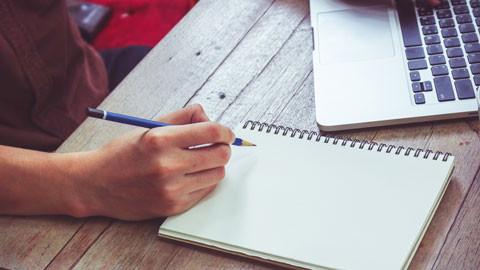
9 Secrets to make an excellent portfolio
Your portfolio is the most important tool for presenting and promoting your art. It should give a clear and comprehensive overview of your work and provide additional information about your art practice. As you can see on this website, portfolios are always required to apply for competitions, stipend and residences, as well as when you show your work to galleries and curators. So it is good to have one ready to be sent out.
Most of the time, people will give you only one chance to attract their interest for your work. It is essential to make a portfolio that will make a strong and lasting impression.
Let´s see how to make a great portfolio in 9 steps:
1. Editing and compression program
First of all, you will have to choose the software program used to make your portfolio. It is an important step as it will have an impact on the quality of your final pdf file. There are lots of great programs to use to edit your portfolio, but not many who also do a good job at compressing the size of your file without losing the high quality of your pictures.
The size of the pdf file is a frequently neglected fact when sending portfolios. Sending a file over 5 MB definitely is a no-go. It will take to long to download and negatively affect the readability of your pdf. Also, a pdf file with lots of pages might not always be well-received. Sending a portfolio under 5 MB with very high quality pictures and the right number of pages will make your portfolio look professional.
Thus, choose a program that offers great tools both to layout your portfolio and to reduce precisely the size of your files without losing the high quality of your photos (like InDesign or the free alternative Scribus)1.
2. Paper format
It is a good choice to take the standard A4 format in the vertical direction. The reason for this is that most applications require an artist statement, a CV and a submission form which will all be in the vertical direction. To have the whole dossier in the vertical direction will be most convenient to the reader. Moreover, you will notice that it is easier to layout text about your artworks if your portfolio is in the vertical format.
3. Structure and length
The first impression provided by your portfolio is absolutely key for the way people will look at your work. This is why it is very important to have a clear structure and a good layout.
On this basis, you might want to structure your portfolio in 5 parts:
- A cover letter, only consisting of one page with your name in an appealing typography followed by the title "Portfolio" underneath;
- Reproductions of your work, on 20 pages maximum;
- Your artist´s statement which should be about half a page which should get people wanting to know more about your art;
- Your CV on one page will inform the reader about the stage of your career;
- Your contact details on the last page will close your portfolio in a clean and professional way.
Many opportunities impose restrictions on the length of your portfolio. Make sure to strictly respect those guidelines. If no guidelines are given, stick to a portfolio of 25 pages maximum, including the cover letter, artist statement, your CV, and contact details.
4. Layout and typography
One key element for making a positive impact with your portfolio is a very clean layout and a well-chosen typography. Both of these elements should be compatible with your work and, ideally, even echo some ideas of your art practice.
You are constantly going to need sending your portfolio either in print or digital versions. Therefore, it is a good choice to stick to an appealing layout and typography which can be used for many purposes. You will then only need to update your portfolio with new works or change small details for the different requirements of any given application.
Layout and typography should be chosen in such a way as to put the focus on your work. Highly original choices risk distracting the reader from the content from your portfolio. You may want to place your pictures in the middle and select classic fonts like Helvetica or Arial in a size between 9 and 11 points.
After having chosen a certain layout type and fonts, the best is to apply these decisions to every document you hand out: portfolio, artist statement, project´s statement, and CV.
5. Photos
Now we come to the core of your portfolio which consists in the reproduction of your art works. It really is important that you have high quality photos which enable the viewer to imagine how they would be in real life.
- Here are a few tips to make good reproductions:
- Always use a high-quality camera and a tripod.
- Be sure that the lightning is optimal for taking photos, the best sources are natural light or two flashes on both sides of your work.
- Ensure that the sharpness of your photos is at the maximum. Always double-check the photos on your computer before finishing a session.
- The best method to reproduce drawings is by carefully scanning them.
- For exhibitions shots, choose the appropriate perspective which will show how the work was placed in space.
- Use photo editing software to make sure the photos are most similar to the original.
- Crop your photos so the works are perfectly placed in your photos.
- In general, you should choose only one photo for each work, but in some cases you will need more; it is best not to exceed two photos per work.
For examples of great exhibition shots, you can look up contemporary art daily and Artviewer which are two of the leading blogs about contemporary art.
6. Work informations
Every page of your portfolio featuring a new work should also provide information in English about the title, the material you used, and the dimension of your work. This information is very important for the viewer who needs to imagine the work in real.
Moreover, many conceptual works require some extra information to fully unfold their potential. Help the viewer with a few accompanying sentences which will provide hints about your work. While making your portfolio, always remember that you are inviting people to get acquainted with your art practice and do not want to exclude them.
7. Placement of the works
The best way to place your works in your portfolio is by ordering them chronologically with the most recent information first. However, sometimes you might want to deviate from this ordering to highlight your most outstanding works or ensure some variety in the presentation.
8. Review and correction
Ask two persons - for instance, one who knows your work and one who does not - for their opinion about your portfolio. Both of them should understand your thoughts and get interesting insights into your work from it. Be open to criticism.
Make sure there are no spelling and grammatical mistakes in your statement. For this you can use one of the many corrections programs on- or off-line.
9. File naming and printing
If you send your portfolio as a pdf file, take care to give it a meaningful name, for instance of the following structure: „Surname_Name_Portfolio.pdf“. This will allow people to know what the file is about and ensure that it will not get lost.
The quality of the print of your portfolio will go a long way to make it appealing to the reader. Always use an appropriate printer. Otherwise, there is a risk that all the hard work you have invested in preparing your portfolio will be lost.
Good luck!1We have no commercial interest in stating this, it is the honest and clear result of our experience and of the one of colleagues who all confirmed this statement.
- By Artenda
- Posted 05.09.2017
6 Essential tips to write an artist´s statement
The artist statement is along with your portfolio one of the most important tools to present and promote your art work. As you can see on our website, artist statements are always required to apply for...
read more
4 Steps to write the perfect artist´s CV
The curriculum vitae is a document which shows your story and your achievements as an artist. Together, your portfolio and your artist statement are one of the important means to present your art practise to others...
read more
6 Steps to write a great art project´s statement
The project statement is, together with your portfolio, one of the most important tools to present and promote your art. As you can see on our website, project statements are always required to apply for competitions and residences...
read more



